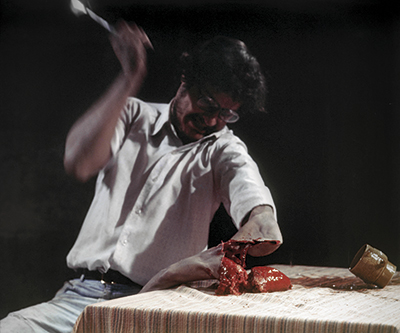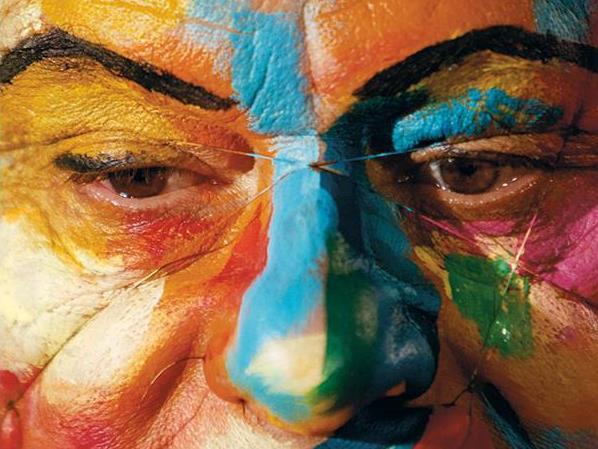Detail, Mike Parr performance The Sickness Unto Death (Sydney, 2015); Courtesy the artist; Photo Paul Green
He has chopped off an arm with a cleaver, sewn his lips together and burnt his leg with a dynamite wick.
Mike Parr is arguably Australia’s most internationally-recognised performance artist. He is notorious for harming his body in the name of art. Over the past four decades he has done everything from pushing a live fish up his nostril to branding his cheek with the word ARTIST.
Can he still shock?
As the National Gallery of Australia (NGA) opens Foreign Looking, a survey exhibition of Parr’s work from the 1970s to the present, we asked Co-Curator Roger Butler about how his work appeals today.
‘I don’t think “appeal” is the right word to describe a Mike Parr exhibition,’ was Butler’s response. ‘The word that often comes up is “disruptive”.’
Butler said a resurgent interest in performance art has introduced Parr to a new generation. ‘That this exhibition is relevant to audiences today is one of our key messages,’ he said.
It is no surprise that the millennials are impressed. Parr’s most infamous performance of 1977 saw him hack off a prosthetic arm with a meat cleaver as an audience watched in horror, and blood and minced meat spilled out.

Mike Parr, Cathartic Action: Social Gestus No. 5 (the “Armchop”) (performance photograph), Sculpture Centre, The Rocks, Sydney, 1977; Courtesy the artist, Photo John Delacour
Foreign Looking, co-curated by Butler, Senior Curator of Australian Prints and Drawings at NGA, and Elspeth Pitt, Curator Australian Art, shows Parr’s work did not become less unsettling as he aged.
‘I guess Mike Parr is always typecast with those early performance works – and they are still extraordinary today – but some of the later works are just as powerful, or more so,’ said Butler.
This year Parr created significant new performance works for the Biennale of Sydney and Hobart’s Dark Mofo. And he will again in Canberra.
The intense work is reflected in the personality of the artist. ‘Mike can be demanding and uncompromising, that is the very reason I like working with him,’ Butler told ArtsHub.
Never before seen work
Spanning nine galleries this exhibition could be described as an installation in its own right, a melding and splicing of performance, film, sculpture and photography. It will both challenge and entice viewers; repel and mesmerise.
Butler said the survey does not seek to amplify those political positions, but he assured us that they are certainly there in this survey.
The exhibition has been curated with a kind of montage ethos. ‘Everything is there. Each room will have a very different feeling, some rooms will be tight and some are bright, while others are more mellow,’ explained Butler.
In the first room Parr has looked at all the films he has produced since the 1970s, and created them into one work across space and time and presented over four screens, explained Butler.
‘It is incredibly worked out; this is Mike at his most precise,’ he said.
Central to the exhibition, and presented on a curved wall, are 40 separate diaries open at a double page spread. Unlike the rest of the exhibition, they are viewed in chronological order, and are distinctive for the red and black ink.
‘They have not been exhibited before. Mike has been keeping these diaries since the 1970s, each day reflecting on the art world, events, financial and political moments. He starts by asking himself a question and then opens that idea up,’ explained Butler.
They are almost like the life force from which this exhibition radiates, pointing to every aspect of Parr’s oeuvre.
A one-off performance
Parr has a particular connection with the NGA, which will be reflected in the creation of a one-off site-specific work for the Gallery.
Like the work the created for Dark Mofo specific to the decommissioned Tasmanian asylum, Willow Court, this one is particular to the Gallery.
‘It couldn’t be done anywhere else,’ Butler revealed.
As for the content, ‘It’s top secret!’ Butler laughed. ‘It will be a one-off performance and something incredibly special.’
The performance will be documented and broadcast live to air, and then that documentation will become part of the survey.
The work plays – or preys – upon Parr’s long history with the NGA, which began when he was invited to create a print for The Bicentennial Folio (a joint commission of the National Gallery of Australia and the Australian Bicentennial Authority). He has since produced more than 300 prints.
‘I have known Mike since I commissioned some of his first prints back in 1988, and we started acquiring his works at the NGA back in 1971,’ Butler told ArtsHub.

Mike Parr’s Best Man, AMERIKA the ice is melting… (Sydney, 2006), make-up Chizuko Saito; Courtesy the artist, Photo Paul Green and PhotoShop Felicity Jenkins
On curating forty years of dissonance
Parr started creating performance works when they were largely considered non-art.
‘No one seemed to know what it was. I had to get used to the idea of sustaining a practice that was outside of the normal reception for visual art. So that gave me a sort of independence,’ he told the National Association for the Visual Arts (NAVA) in an interview.
That sustainability and drive to innovate and experiment, at all cost, has remained across his four-decade career, and the lens that this survey offers to artists casts Parr as a luminary.
‘Mike had a checklist and we had a checklist and we worked it out. It has to be collaborative working with an artist like Mike,’ Butler told ArtsHub. Trust is central to that process.
A couple of years ago Parr gifted his archive to the NGA. A key component of the survey is a pop up space that takes its cue from the artist run space, Inhibodress that Parr formed in 1970 with artists Peter Kennedy and Tim Johnson.
It was there that he realised the shock value of his art. The space was an old blouse factory, and with no prior context, was the first experimental collective space in Australia.
Parr would sit on a desk and ask questions. In that spirit, an NGA archivist will work in the room one day a week cataloguing the Parr archive, surrounded by Parr’s correspondence, archives, music from the era.
Everything goes full circle in Foreign Looking, and amid the echoes of time and memories, the past continues to inform – and unsettle – the present.
Mike Parr: Foreign Looking is showing at the National Gallery of Australia 12 August – 16 November. Free Entry.






